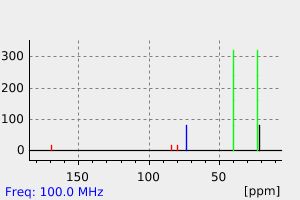1-ethynylcyclopentyl acetate | 36193-52-9
中文名称
——
中文别名
——
英文名称
1-ethynylcyclopentyl acetate
英文别名
Xdcsxisapsvxqc-uhfffaoysa-;(1-ethynylcyclopentyl) acetate
CAS
36193-52-9
化学式
C9H12O2
mdl
——
分子量
152.193
InChiKey
XDCSXISAPSVXQC-UHFFFAOYSA-N
BEILSTEIN
——
EINECS
——
-
物化性质
-
计算性质
-
ADMET
-
安全信息
-
SDS
-
制备方法与用途
-
上下游信息
-
文献信息
-
表征谱图
-
同类化合物
-
相关功能分类
-
相关结构分类
物化性质
-
沸点:178.0±19.0 °C(Predicted)
-
密度:1.03±0.1 g/cm3(Temp: 20 °C; Press: 760 Torr)(Predicted)
计算性质
-
辛醇/水分配系数(LogP):1.3
-
重原子数:11
-
可旋转键数:3
-
环数:1.0
-
sp3杂化的碳原子比例:0.67
-
拓扑面积:26.3
-
氢给体数:0
-
氢受体数:2
反应信息
-
作为反应物:描述:1-ethynylcyclopentyl acetate 在 [Au(Cl)PPh3] 、 F5Sb*AgF 、 水 作用下, 以 1,4-二氧六环 为溶剂, 反应 2.0h, 以96%的产率得到1-acetylcyclopentyl acetate参考文献:名称:邻羰基辅助的金催化乙酸丙炔酯的区域选择性水合:获得α-酰氧基甲基酮和(±)-Actinopolymorphol B的合成†摘要:通过范围广泛的乙酸炔丙酯的区域选择性水合证明了合成α-酰氧基甲基酮的一般的原子经济方法。在二恶烷-H 2 O中包含1%Ph 3 PAuCl和1%AgSbF 6的现成催化剂可在短时间内在环境温度下在短短时间内有效地水解炔丙基乙酸酯的末端炔烃。如18所示,相邻的羰基可促进有效的区域选择性水化O标记研究。观察到功能部分的相容性和对各种酸不稳定的保护基的耐受性。催化条件也适合于进行TMS取代的炔丙基乙酸酯的水合作用,即使需要更长的反应时间才能完成。在水合过程中保留了炔丙基乙酸酯的立体完整性。通过以几乎定量的产量进行克规模的产品制备,成功地证明了该系统的鲁棒性。普通的α-酰氧基甲基酮被转化为1,2-二醇和1,2-氨基醇衍生物。肌动蛋白多酚B的合成首次实现,其中乙酸炔丙基酯的水合是关键步骤。DOI:10.1021/jo101995g
-
作为产物:描述:参考文献:名称:Unsaturated spiro-γ-lactone formation by the dissociative reduction of bromoacetates摘要:Unsaturated spiro-gamma-butyrolactones can be prepared in good yields from bromoacetate precursors by a simple route that requires only 2-propanol as solvent and free radical initiation.DOI:10.1016/s0040-4039(00)97292-7
文献信息
-
Palladium-Catalyzed [2+1] Cycloadditions Affording Vinylidenecyclopropanes as Precursors of 7-Membered Carbocycles作者:Aymeric Lepronier、Thierry Achard、Laurent Giordano、Alphonse Tenaglia、Gérard Buono、Hervé ClavierDOI:10.1002/adsc.201500971日期:2016.2.18Palladium(II) acetate in association with secondary phosphine oxides provides an efficient catalytic system for [2+1] cycloadditions starting from oxanorbornene derivatives and tertiary propargyl esters giving rise to vinylidenecyclopropanes. This reaction is specific to bidentate phosphinito–phosphinous acid ligands generated from secondary phosphine oxides. The [2+1] cycloaddition was found broad
-
Trialkylborane-Mediated Propargylation of Aldehydes Using γ-Stannylated Propargyl Acetates作者:Yoshikazu Horino、Miki Murakami、Mayo Ishibashi、Jun Hee Lee、Airi Watanabe、Rio Matsumoto、Hitoshi AbeDOI:10.1021/acs.orglett.9b03710日期:2019.12.6A transition-metal-free three-component process that combines aldehydes, 3-(tributylstannyl)propargyl acetates formed in situ from readily available propargyl acetates, and trialkylboranes provides access to a range of 1,2,4-trisubstituted homopropargylic alcohols. The addition of diisopropylamine plays a crucial role in the selective formation of homopropargylic alcohols. Importantly, this methodology
-
Ru-Catalyzed Ring-Opening and Substitution Reactions of Heteroaromatic Compounds Using Propargylic Carboxylates as Precursors of Vinylcarbenoids作者:Koji Miki、Michinobu Fujita、Sakae Uemura、Kouichi OheDOI:10.1021/ol0604769日期:2006.4.1[reaction: see text] The reaction of heteroaromatic compounds with propargylic carboxylates in the presence of a catalytic amount of [RuCl(2)(CO)(3)](2) or PtCl(2) gives trienes in good yields. The key intermediate is an electrophilic (1-acetoxylvinyl)carbene complex generated from the activated propargylic acetates with transition metals.
-
Über eine neue Synthese von Citral und verwandten Verbindungen作者:G. Saucy、R. Marbet、H. Lindlar、O. IslerDOI:10.1002/hlca.19590420624日期:——A new method for the preparation of α,β-unsaturated aldehydes and α,β;γ,δ-unsaturated ketones is described. The method is based upon the rearrangement of acetates of tertiary ethynyl carbinols to allenic acetates in the presence of acetic acid and silver or copper catalyst; partial conversion of the allenic acetates to diacetates takes place under the reaction conditions. In some cases enol acetates
-
Ruthenium-Catalyzed Cyclopropanation of Alkenes Using Propargylic Carboxylates as Precursors of Vinylcarbenoids作者:Koji Miki、Kouichi Ohe、Sakae UemuraDOI:10.1021/jo034841a日期:2003.10.1carboxylates 1 are catalyzed by [RuCl2(CO)3]2 to give vinylcyclopropanes 2 in good yields. The key intermediate of the reaction is a vinylcarbene complex generated in situ by nucleophilic attack of a carbonyl oxygen of the carboxylates to an internal carbon of the alkyne activated by the ruthenium complex. A variety of transition-metal compounds other than the Ru compound can also be employed in this
表征谱图
-
氢谱1HNMR
-
质谱MS
-
碳谱13CNMR
-
红外IR
-
拉曼Raman
-
峰位数据
-
峰位匹配
-
表征信息
同类化合物
(反式)-4-壬烯醛
(s)-2,3-二羟基丙酸甲酯
([1-(甲氧基甲基)-1H-1,2,4-三唑-5-基](苯基)甲酮)
(Z)-4-辛烯醛
(S)-氨基甲酸酯β-D-O-葡糖醛酸
(S)-3-(((2,2-二氟-1-羟基-7-(甲基磺酰基)-2,3-二氢-1H-茚满-4-基)氧基)-5-氟苄腈
(R)-氨基甲酸酯β-D-O-葡糖醛酸
(5,5-二甲基-2-(哌啶-2-基)环己烷-1,3-二酮)
(2,5-二氟苯基)-4-哌啶基-甲酮
龙胆苦苷
龙胆二糖甲乙酮氰醇(P)
龙胆二糖丙酮氰醇(P)
龙胆三糖
龙涎酮
齐罗硅酮
齐留通beta-D-葡糖苷酸
鼠李糖
黑芥子苷单钾盐
黑海棉酸钠盐
黑木金合欢素
黑曲霉三糖
黑介子苷
黄尿酸8-O-葡糖苷
麻西那霉素II
麦迪霉素
麦芽糖脎
麦芽糖基海藻糖
麦芽糖1-磷酸酯
麦芽糖
麦芽四糖醇
麦芽四糖
麦芽十糖
麦芽六糖
麦芽五糖水合物
麦芽五糖
麦芽五糖
麦芽五糖
麦芽三糖醇
麦芽三糖
麦芽三糖
麦芽三塘水合
麦芽七糖水合物
麦芽七糖
麦法朵
麦可酚酸-酰基-Β-D-葡糖苷酸
麦利查咪
麝香酮
鹤草酚
鸢尾酚酮 3-C-beta-D-吡喃葡萄糖苷
鸡矢藤苷







